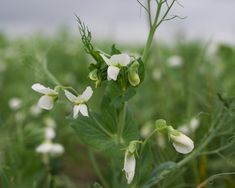Princess pea
With the aim of providing information about the importance of crops for agriculture and nutrition, the Society for Crop Science held its first-ever Crop of the Year election. A member poll selected the pea as this year's winner. "Domesticated more than 9,000 years ago north of the Arabian Peninsula, the pea has multiple uses as a forage crop, dry pea and raw material supplier for the food industry," emphasizes Hans-Peter Kaul of BOKU's Institute of Crop Science and president of the Gesellschaft für Pflanzenbauwissenschaften e.V. "Physiologically unripe when harvested, it is a tasty vegetable, while mature peas have high levels of valuable protein and starch."
As a legume, pea can fix nitrogen from the air due to its symbiosis with nodule bacteria of the genus Rhizobium. This makes it independent of nitrogen fertilization and thus indispensable in crop rotation in organic farming at many locations. If the partners harvest at the same time, mixed crops with the aim of harvesting the ripe grain are also possible. This is particularly interesting for organic farms to achieve improved weed suppression. The overall productivity of mixed crops can also be increased. Spring barley has proven to be a support crop and partner. Although winter forms exist, pea is predominantly grown as a summer crop. In crop rotations heavy on cereals and winter crops, the integration of pea can break infection chains and counteract one-sided weediness. Its high preceding crop value also results from the build-up of stable humus forms and the potential savings in nitrogen fertilizers.
Vegetable peas are grown on just over 150,000 hectares in the EU. The main producers are France, Hungary, Spain, Italy and Belgium. In Germany, the production area in 2021 was about 5,000 hectares, and in Austria, vegetable peas were cultivated on about 2,200 hectares. The very largest part of the production volume is processed into frozen products. Due to the lack of storability of hand-picked fresh market peas, their importance in cultivation is secondary.
In the EU, grain pea is now only the second most important grain legume due to the expansion of soybean production. The total area cultivated with grain legumes was just under 3% of the EU's arable land in 2020. In countries such as Austria, Italy, Romania and Hungary, soybean cultivation dominates due to the warmer climate. Pea therefore plays a minor role in these countries.
Further information
www.gpw.uni-kiel.de/de/kulturpflanze-des-jahres/2022
PDF for download
www.gpw.uni-kiel.de/de/kulturpflanze-des-jahres/2022/erbse

